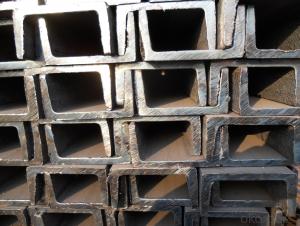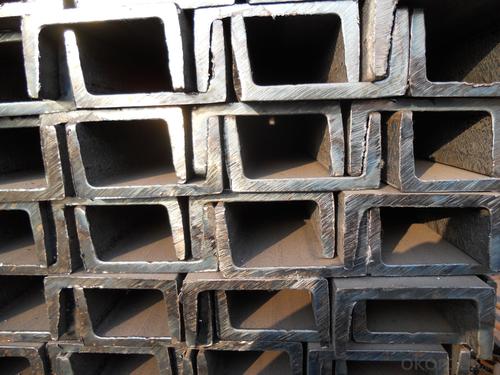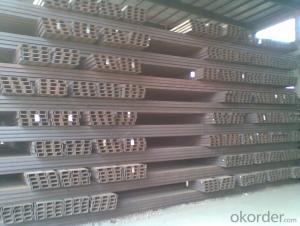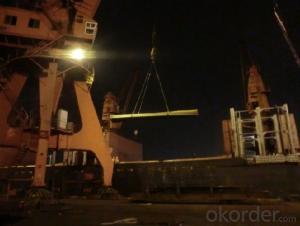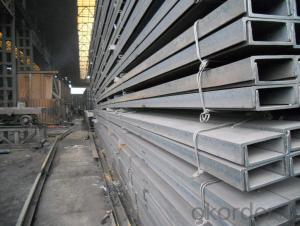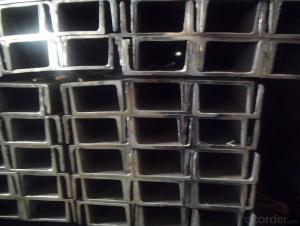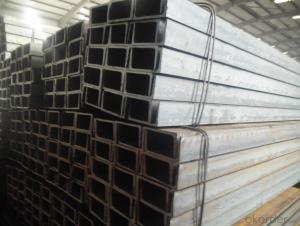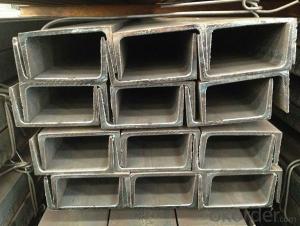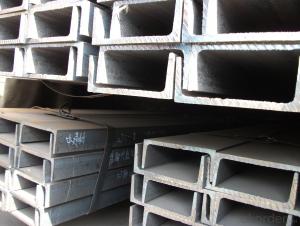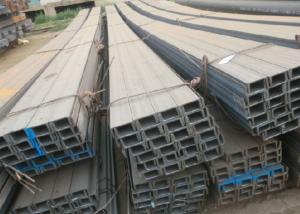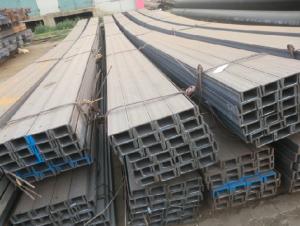Hot Rolled Steel U Channels with EN Standard for Construction
- Loading Port:
- China main port
- Payment Terms:
- TT or LC
- Min Order Qty:
- 25000 m.t.
- Supply Capability:
- 200000 m.t./month
OKorder Service Pledge
OKorder Financial Service
You Might Also Like
Specifications of Hot Rolled Steel U Channels with EN Standard for Construction:
1.Our UPN Channel Steel has lots of advantages, just as followings:
a) At reasonable price and good quality.
b) To be convenient in construction and to save much time and labor.
c) The length of UPN can be manufactured according to customer’s requirements.
d) The UPN Channel Steel has strong mechanical strength.
e). The UPN Channel Steel possesses various kind of fittings, through which it is suitbal for many combinations.
f) Our UPN Channel Steel is attractive in appearance as well as beautiful in design
g) Free from slotted punching
2. The detailed sections of our UPN Channel Steel can be found in table-1
UPN U CHANNEL | Standard h | Sectional b | Dimension s | t | Mass: Kg/m |
| (mm) | (mm) | (mm) | (mm) |
|
80x45 | 80 | 45 | 6.0 | 8.0 | 8.64 |
100X50 | 100 | 50 | 6.0 | 8.5 | 10.6 |
120x55 | 120 | 55 | 7.0 | 9.0 | 13.4 |
140x60 | 140 | 50 | 7.0 | 10.0 | 16.0 |
160x65 | 160 | 65 | 7.5 | 10.0 | 18.8 |
180x70 | 180 | 70 | 8.0 | 11.0 | 22.0 |
Table-1
Note: we are definitely good at manufacturing and supplying UPN channel steel as per S235JR. Also, we are willing and able to provide our customers UPN channel steel in other sizes, which depends on customers’ concret requirements for the quantity.
3. The chemical composition of UPN Channel Steel as per S235JR is shown in the table-2
Alloy No | Element(%) | ||||
C | Mn | S | P | Si | |
S235JR | 0.12—0.20 | 0.3—0.7 | ≤0.030 | ≤0.030 | ≤0.20 |
Table-2
4. The mechanical property of UPN Channel Steel as per S235JR is shown in the table-3-1 and table-3-2
Alloy No | Yielding strength point( Mpa) | |||
Thickness (mm) | ||||
≤16 | >16--40 | >40--60 | >60--100 | |
≥ | ||||
S235JR | 235 | 225 | 215 | 195 |
Table-3-1
Alloy No | Tensile strength (Mpa) | Elongation after fracture(%) | |||
Thickness (mm) | |||||
| ≤16 | >16--40 | >40--60 | >60--100 | |
≥ | |||||
S235JR | 340--510 | 24 | 23 | 22 | 27 |
Table-3-2
Applications of Hot Rolled Steel U Channels with EN Standard for Construction:
The UPN Channel Steel can be applied to construction of warehouses, workshops, sport stadiums and car parks etc.The hot rolled channel steel belongs to carbon structural steel which is applied to in the field of construction and machinery.In details, the hot rolled channel steel is usually used for arch-itechtural structure, and they could be welded in order to support or hang a vari-ety of facilities. They are also usually used in combination with I beam. Generally,the hot rolled channel steel we supply must possess perfect welding property, riveting property and mechanical property and so on.
Package & Delivery of Hot Rolled Steel U Channels with EN Standard for Construction:
1.The channel steel will be packed in bundle with steel wire at each end of every bundle and color marking in order to help the customer to recognize his goods more easily at sight.
2. And the channel steel could be loaded into 20ft or 40ft container, or by bulk cargo.If the weight of each bundle reaches more than 3.5 mt, the loading by break bulk cargo should be choosed.When the weight of each bundle reaches less than 3mt, the loading by container should be choosed.
3.As for the transportaion from mill to loading port, the truck will be usually used. And the maximum quantity for each truck is 40mt.
4.All in all, we could do in accordance with customer's request.
Production Flow of Hot Rolled Steel U Channels with EN Standard for Construction:
1.The steel billet shall be heated in the high temperature furnace.
2. The heated steel billet shall be rolled five to nine times with the aim of shaping the general figure of steel u channel.
3. The rolled steel u channel should be put onto the cooling bed to make the temperature low.
4. The steel u channel should be straighted on the straightener.
5. The straighted steel u channel will be cut into meters by saw, as per customer's requirements.
6. At the last part of production, the channel steel must be tested in order to confirm that the finished products are completely free from crack, pore, slag, scab or fold on the surface.
FAQ:
Q1: How soon can we receive the product after purchase?
A1: Within three days of placing an order, we will begin production. The specific shipping date is dependent upon international and government factors, but is typically 7 to 10 workdays.
Q2: What makes stainless steel stainless?
A2: Stainless steel must contain at least 10.5 % chromium. It is this element that reacts with the oxygen in the air to form a complex chrome-oxide surface layer that is invisible but strong enough to prevent further oxygen from "staining" (rusting) the surface. Higher levels of chromium and the addition of other alloying elements such as nickel and molybdenum enhance this surface layer and improve the corrosion resistance of the stainless material.
Q3: Can stainless steel rust?
A3: Stainless does not "rust" as you think of regular steel rusting with a red oxide on the surface that flakes off. If you see red rust it is probably due to some iron particles that have contaminated the surface of the stainless steel and it is these iron particles that are rusting. Look at the source of the rusting and see if you can remove it from the surface.
Images:
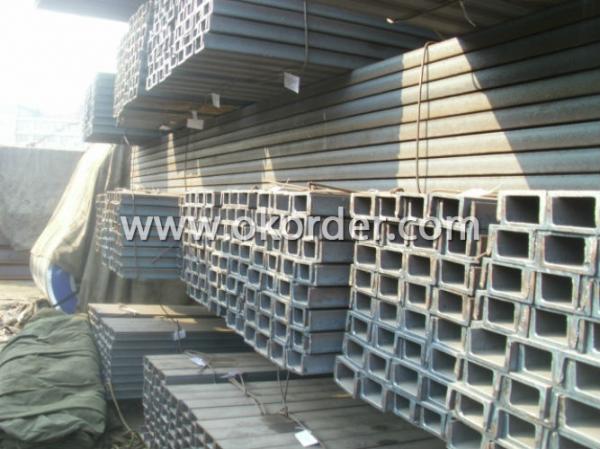
- Q: What are the methods and the price of building the floor?
- Your house must have enough floor height. In general, the lower floor of the new attic in the duplex room is flat with the lower edge of the original floor. A single mezzanine floor with a lower margin of not less than 2.6 meters. In the attic floor and the roof height of not less than 2.4 meters, a minimum of not less than 2.2 meters. This is based on the premise that people are living. If your attic is not available, then you can make your own discretion.
- Q: What are the advantages of using steel channels?
- There are several advantages to using steel channels in various construction and structural applications. Firstly, steel channels are known for their excellent strength and durability. They can withstand heavy loads and provide structural stability, making them suitable for supporting beams, columns, and other load-bearing elements in buildings and bridges. Another advantage of steel channels is their versatility. They come in various sizes and shapes, allowing for flexibility in design and construction. Steel channels can be easily cut, welded, and manipulated to fit specific requirements, making them a preferred choice for customized structures. Steel channels also offer excellent fire resistance. As a non-combustible material, steel does not contribute to the spread of fire, providing increased safety in buildings. Moreover, steel channels are resistant to corrosion, rust, and decay, making them suitable for both indoor and outdoor applications. This resistance to environmental factors ensures the longevity and low maintenance of structures using steel channels. Furthermore, steel channels are cost-effective in the long run. While the initial investment may be higher compared to other materials, their durability and low maintenance requirements result in reduced repair and replacement costs over time. Additionally, steel is a recyclable material, making it an environmentally friendly choice. Lastly, steel channels have a high aesthetic appeal. The sleek and modern appearance of steel can enhance the visual appeal of structures, making them a preferred choice for architects and designers. In conclusion, the advantages of using steel channels include their strength, versatility, fire resistance, corrosion resistance, cost-effectiveness, and aesthetic appeal. These factors make steel channels a popular choice in various construction and structural applications.
- Q: What are the common design considerations for steel channels?
- When designing steel channels, there are several common considerations that need to be taken into account. These considerations include the following: 1. Load capacity: One of the primary design considerations for steel channels is their load-bearing capacity. The channel must be able to support the applied loads without experiencing excessive deflection or failure. This involves calculating the maximum expected loads and selecting a channel size and material that can safely carry these loads. 2. Material selection: Steel channels are available in various materials, including carbon steel and stainless steel. The material selection depends on factors such as the required strength, corrosion resistance, and cost. Different steel grades have different mechanical properties, and the appropriate material must be chosen based on the specific application. 3. Structural stability: Steel channels must possess adequate structural stability to resist buckling or collapsing under the applied loads. The design should consider the channel's length, support conditions, and the potential for lateral torsional buckling. By analyzing these factors, appropriate design measures can be taken to ensure the stability of the channel. 4. Connection design: Another important consideration is the design of the connections between steel channels and other structural elements. The connections must be designed to transfer loads effectively and securely, ensuring the overall structural integrity of the system. Factors such as joint type, fastener selection, and weld design need to be considered for proper connection design. 5. Fire resistance: In certain applications, fire resistance is a critical consideration for steel channels. The design should account for the required fire rating by incorporating appropriate fire protection measures, such as intumescent coatings or fire-resistant insulation materials. 6. Manufacturing constraints: The design must also take into consideration the manufacturing constraints involved in producing steel channels. This includes considerations such as standard sizes, manufacturing tolerances, and availability of specific profiles. By working within these constraints, the design can be optimized for ease of production and cost-effectiveness. In conclusion, when designing steel channels, it is crucial to consider factors such as load capacity, material selection, structural stability, connection design, fire resistance, and manufacturing constraints. By addressing these considerations, engineers can develop safe and efficient designs for steel channels that meet the specific requirements of the intended application.
- Q: I encountered in the construction of 2 short 28# channel welding, processed into beams, how to weld? Do I have to have stiffened panels? How many pieces? What's the thickness of the stiffener? I heard that there is a book called "metal processing manual", which has instructions, but I do not have the book. Please give settlement.
- This is called the welding [] [] button, the back button is welded. [] relatively buckle welding should be simple, if there is no external size limit, you can make two channels are reserved in the middle of a certain gap, with one side welding double side molding method, usually without the middle plate. But 28[, at the end of his the flange is not very thick <9mm, so this welding method is relatively simple, if there is a peripheral size limit, which is in the middle gap is 0, then the 9mm plate thickness on the slightly better welders is simply a penetration problem.[] back button welded together relative to the trouble, but it is not used much, unless there is a special purpose, otherwise it is generally not considered.
- Q: How do steel channels perform in extreme temperature conditions?
- Steel channels perform well in extreme temperature conditions due to their high thermal conductivity and low thermal expansion coefficient. This means that steel channels are able to efficiently transfer heat and cold, allowing them to maintain their structural integrity and stability in extreme temperature environments. Additionally, steel channels have a high melting point, which makes them resistant to deformation or structural failure even at high temperatures. The strength and durability of steel also contribute to its performance in extreme temperature conditions, as it is less likely to warp, bend, or crack under thermal stress. Overall, steel channels are a reliable choice for applications requiring stability, strength, and resistance to extreme temperatures.
- Q: How are steel channels protected against corrosion?
- Steel channels can be protected against corrosion through various methods. One common method is the application of a protective coating, such as paint or epoxy, on the surface of the channels. This coating acts as a barrier between the steel and the corrosive elements in the environment, preventing direct contact and reducing the risk of corrosion. Another method is the use of galvanization, which involves coating the steel channels with a layer of zinc. This zinc coating acts as a sacrificial layer, meaning that it corrodes instead of the steel when exposed to corrosive elements. This helps to extend the lifespan of the steel channels and provide long-term protection against corrosion. In addition to protective coatings, steel channels can also be protected through the use of cathodic protection. This involves the application of an electric current to the steel channels, which helps to neutralize the corrosive reactions that lead to corrosion. Cathodic protection is often used in conjunction with other protective measures to provide effective corrosion protection. Regular maintenance and inspection are also crucial in protecting steel channels against corrosion. Any signs of damage or deterioration should be identified and addressed promptly to prevent further corrosion. Cleaning the channels regularly and removing any contaminants or debris can also help to minimize the risk of corrosion. Overall, a combination of protective coatings, galvanization, cathodic protection, and regular maintenance can effectively protect steel channels against corrosion and extend their lifespan.
- Q: How do steel channels perform in corrosive environments?
- Steel channels perform relatively well in corrosive environments due to their inherent corrosion resistance. The addition of alloying elements, such as chromium and nickel, in the steel composition enhances their resistance to corrosion. Furthermore, protective coatings, such as galvanization or painting, can be applied to steel channels to provide an additional layer of protection against corrosion. Overall, steel channels are a reliable choice for applications in corrosive environments.
- Q: What are the common lengths of steel channels?
- The common lengths of steel channels vary, but they are typically available in standard lengths of 20 feet or 6 meters.
- Q: What does "channel 160*60*20*2.5" mean in steel roof trusses? What is the specific weight?
- 160mm tall, 60mm wide, 2.5mm thick20mm is the size of two small ears. It's called C shape steel.2.5 of the proportion is 5.87kg/m
- Q: How do steel channels contribute to the stability of a structure?
- Steel channels contribute to the stability of a structure in several ways. Firstly, they provide additional structural support by distributing the load evenly across the structure. The shape of the channel, with its flanges and web, helps to resist bending and twisting forces, preventing any potential collapse or deformation of the structure. Moreover, steel channels enhance the overall strength and rigidity of the structure. The high tensile strength of steel allows for the channels to bear heavy loads without buckling or warping. This added strength and rigidity help to maintain the structural integrity of the building, ensuring its stability during various external forces such as wind, earthquakes, or heavy loads. Steel channels also contribute to the stability of a structure by providing a stable base or foundation. They can be used as beams or columns to support the weight of the structure and transfer the load to the foundation. In this way, steel channels act as a strong and reliable support system, preventing any excessive movement or settlement of the structure. Additionally, steel channels offer versatility in design and construction. They can be easily fabricated into various shapes and sizes to suit the specific needs of the structure. This flexibility allows for efficient and cost-effective construction methods, ensuring stability without compromising on design aesthetics or functionality. In conclusion, steel channels play a vital role in ensuring the stability of a structure. By providing additional support, enhancing strength and rigidity, acting as a stable base, and offering design versatility, steel channels contribute to the overall stability and integrity of a building, making it safe and reliable for its intended purpose.
Send your message to us
Hot Rolled Steel U Channels with EN Standard for Construction
- Loading Port:
- China main port
- Payment Terms:
- TT or LC
- Min Order Qty:
- 25000 m.t.
- Supply Capability:
- 200000 m.t./month
OKorder Service Pledge
OKorder Financial Service
Similar products
Hot products
Hot Searches
Related keywords
